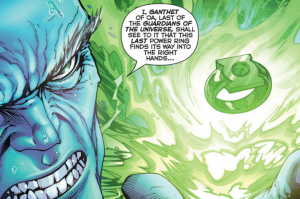Batman’s continuity has taken quite a beating since the launch of the New 52, including here at this site, because of the inexact nature of the timeline (and particularly how that timeline might be applied to Damian Wayne, Batman’s son and the current Robin) — but in spite of being almost equally confusing, Green Lantern has been given much more of a pass by most fans and critics.This could be for any number of reasons, not least of which is that Green Lantern has made only minimal attempts on the page to clarify the complex backstory they were allowed to keep while the rest of the DC Universe was given a total face-lift. Yes, Blackest Night happened–although obviously it happened differently than we remember because Ted Kord and Kal-L never existed in the New 52. What were the nature of those changes? It’s not important, and not mentioned. Fair enough.That strategy has seemed to work for Geoff Johns pretty well; he can more or less decree that in the last five years, just about every important Green Lantern story has happened, and that any of them that don’t make any sense, that’s just because you’re thinking too hard. And he can get away with that because, by providing very little in the way of details, it forces the fan to think himself into a continuity conflict.As opposed to, say, Batman, who laid out a timeline for both the beginning of Bruce’s Batman career and the birth of Damian and then went on to show with art on the page how those two timelines seemed to contradict one another.So, alright–specificity is, in this case, the enemy of the kind of overall logic that The New 52 hopes to promote in Green Lantern and Batman‘s “un-rebooted” timelines. Fair enough.So why would anyone let this latest tweak to Kyle Rayner’s already-strained origin story go to press?In the pre-reboot continuity, Kyle Rayner was introduced when Hal Jordan was driven mad and adopted the identity of Parallax, the cosmic parasite that had corrupted him. During the time he was insane, Jordan destroyed the central power battery, effectively dismantling the Green Lantern Corps, and the Guardians of the Galaxy appeared to have sacrificed themselves in order to give one of the few “named” Guardians, Ganthet, a final Green Lantern ring and battery–and a final shot at salvaging all they had built.That ring, of course, went to Kyle Rayner because “you’ll have to do” and over the course of a hundred-odd issues, Kyle was the only Green Lantern in the universe, trying to fill big boots with little or no guidance.His role as the “torch bearer” became essential to his persona after the Corps was re-established, since there was suddenly so little distinguishing him from other Corps members. In the time since, that role has evolved somewhat, with Rayner adopting the identity of Ion at first (a personification of the Lantern’s energy that distinguished him from other Corps members and made him a kind of Messiah for the GL Corps) and now the leader of the New Guardians, a Corps made up of one representative from each color of the emotional spectrum. He was already pointed in that direction before the reboot, but Green Lantern: New Guardians solidified it, giving only the briefest glimpse of Kyle’s origin in its first issue.











